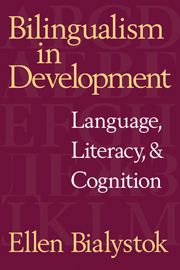2 - Starting with One Language
Published online by Cambridge University Press: 02 December 2009
Summary
The pattern is familiar: cries evolve to babbles, babbles are shaped into words, and words are joined to create sentences. This sequence describes the path taken by all children as the language they hear around them is examined, internalized, and eventually developed into native-speaker competence. Although recent research has shown the immense variability in both rate and achievement for children learning their first language (Fenson et al., 1994), the process nonetheless has an enviable consistency about it, especially compared with the erratic and idiosyncratic variability of second-language acquisition. But these visible landmarks of progress in themselves reveal little of the internal complexities and mental revolutions that are propelling the child into linguistic competence. How do children learn language? We begin by trying to understand how a child learns one language in a relatively simple cognitive and social environment, so that when the stakes are raised, we have a basis for describing and interpreting a child's experience with multiple languages in complex social circumstances.
The formal study of language acquisition began with the scrupulous observation of young children learning to talk. Before there was a single hypothesis probing the nature of this process, researchers were recording the speech of their children and creating a database. The most famous of these was Leopold (1939–49) whose four-volume report remains a classic in the field. Interestingly, Leopold's daughter, the subject of the study, was being raised bilingually, although it took several decades for the study of bilingualism and second-language learning to gain a respectable position in studies of language acquisition. Beginning in the late 1950s, Roger Brown and his students carried out the first major program of research into child language acquisition that incorporated both observation and experimental manipulation.
- Type
- Chapter
- Information
- Bilingualism in DevelopmentLanguage, Literacy, and Cognition, pp. 21 - 55Publisher: Cambridge University PressPrint publication year: 2001



